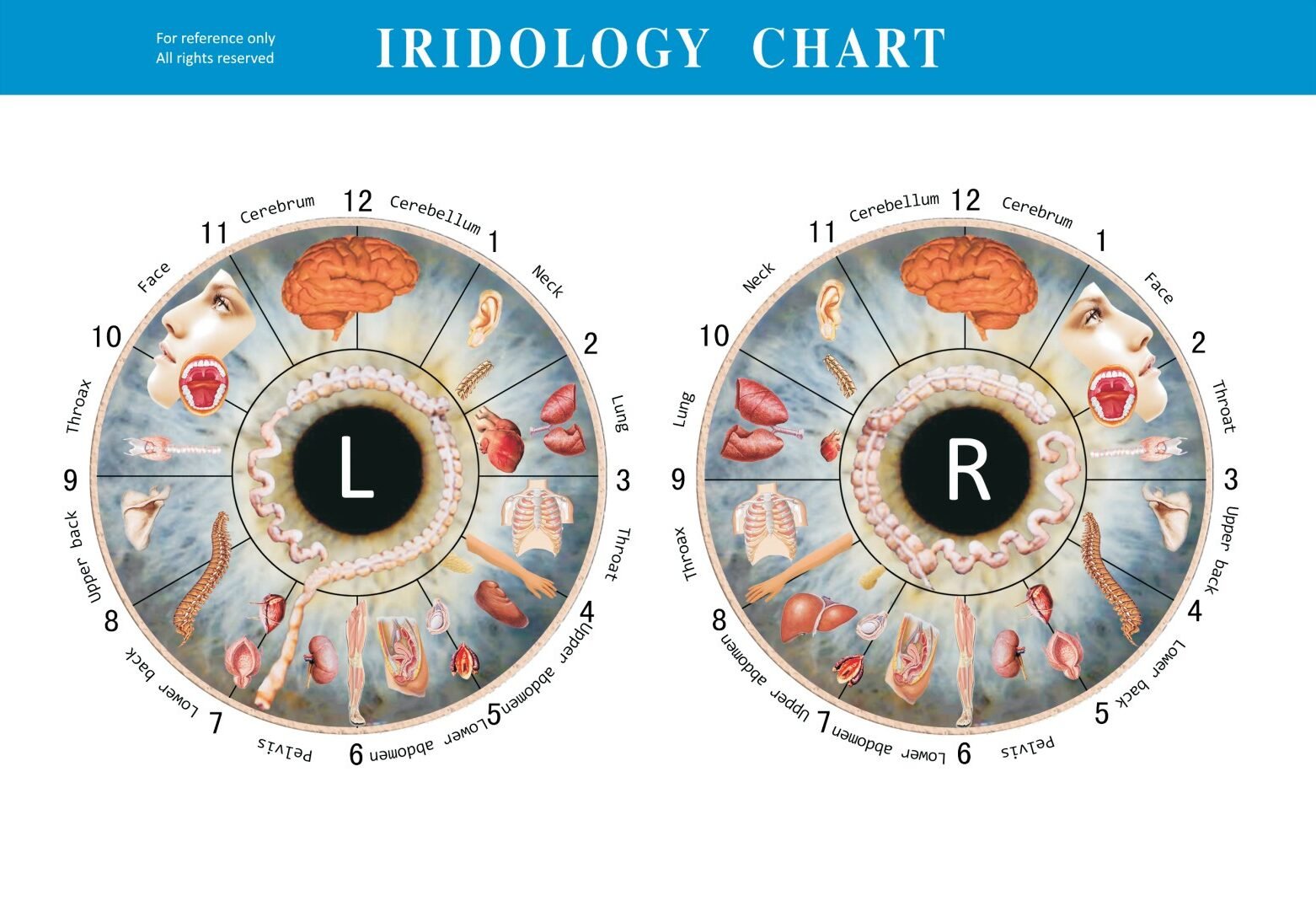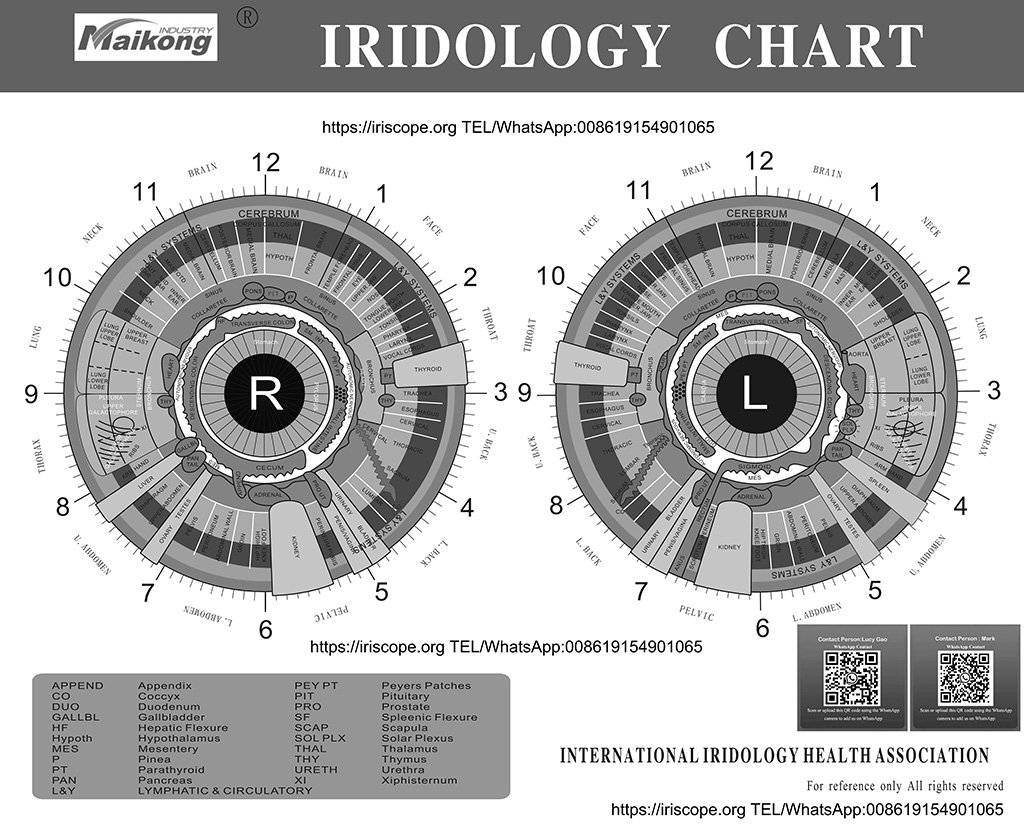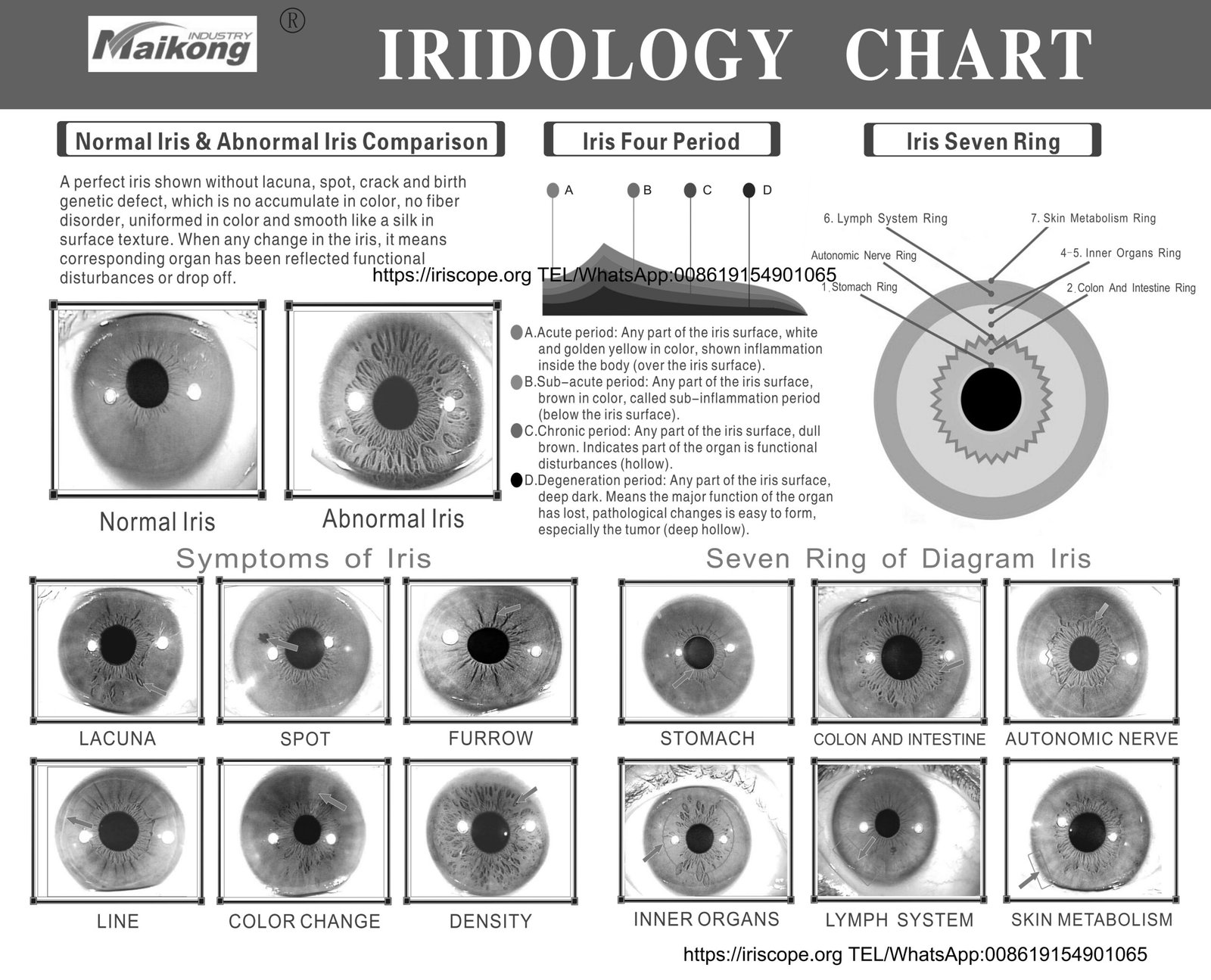The intricate patterns within your iris reveal more than just your eye color—they can provide valuable insights into your health. عبادت, the study of the iris’s structure and pigmentation, has been practiced for centuries as a method of assessing health conditions and predispositions. Each mark, color variation, and structural feature in your iris tells a unique story about your body’s past, present, and potential future health status.
 As global leaders in professional ایریدولوژی equipment, we’ve created this comprehensive guide to help you understand the fascinating language of iris symbols and their interpretations in health assessment.
As global leaders in professional ایریدولوژی equipment, we’ve created this comprehensive guide to help you understand the fascinating language of iris symbols and their interpretations in health assessment.
نمودار جامع ایریدولوژی نقشه برداری مناطق عنبیه به سیستم های بدن
The Historical Development of Iridology Symbols
The systematic study of iris patterns dates back centuries, with significant developments occurring in the 19th century. Dr. Ignaz von Peczely, a Hungarian physician, is widely recognized as the father of modern iridology. In the 1860s, he created the first detailed iris chart after noticing changes in an owl’s iris following the bird’s leg injury.
Dr. Ignaz von Peczely, pioneer of modern iridology techniques
Von Peczely’s work was later expanded by Swedish homeopath Nils Liljequist, who observed changes in his own iris after taking medications. In the 20th century, American chiropractor Bernard Jensen further developed iridology charts and techniques, creating the widely used Jensen chart that maps the iris to various organs and body systems.
Today, professional iridology practitioners use advanced equipment like digital iriscopes and specialized software to capture and analyze iris details with unprecedented precision, allowing for more accurate interpretation of health indicators.
Understanding Iris Structure in Iridology
Before diving into specific symbols, it’s essential to understand the basic structure of the iris as viewed in iridology. The iris is divided into several zones, each corresponding to different body systems and organs.
Primary Zones of the Iris in Iridology
- Pupillary Zone – The area surrounding the pupil, representing the digestive system and intestines
- Ciliary Zone – The middle area of the iris, corresponding to most major organs and body systems
- Iris Edge – The outer boundary of the iris, associated with the skin, lymphatic system, and circulation
- Collarette – The jagged boundary between the pupillary and ciliary zones, indicating the state of the autonomic nervous system
The iris is further divided into clock-like sectors, with each sector corresponding to specific organs or body systems. In professional iridology practice, these sectors are analyzed in conjunction with specific markings and color variations to form a comprehensive health assessment.
Common Iridology Markings and Their Meanings
Iridology practitioners identify various markings in the iris that can indicate different health conditions. Here are the most significant symbols and their interpretations:
Lacunae in Iridology
Lacunae are enclosed dark areas in the iris that represent inherent weaknesses or lesions in corresponding organs. Their depth, size, and location provide valuable information about the severity and chronicity of conditions.
Crypts and Their Significance
Crypts are small openings or pits in the iris fiber structure. In iridology, they often indicate genetic predispositions and can reveal inherited health tendencies from previous generations.
Radii Solaris Patterns
Radii solaris appear as spoke-like lines radiating outward from the pupil. These markings in iridology often indicate toxicity, inflammation, or irritation in the corresponding organ or system.
Pigment Spots and Deposits
Pigment spots appear as colored deposits in the iris. In iridology analysis, their color and location can indicate various conditions:
- لکه های قهوه ای – Often indicate chemical deposits or mineral accumulation
- Orange spots – May suggest issues with carbohydrate metabolism
- Yellow spots – Can indicate kidney or urinary tract concerns
Nerve Rings and Stress Indicators
Nerve rings appear as concentric circles in the iris. In iridology, they typically indicate nervous tension, stress, and anxiety. Multiple or pronounced nerve rings may suggest chronic stress conditions affecting overall health.
Lymphatic Rosary Signs
The lymphatic rosary appears as a white, cloud-like formation around the outer edge of the iris. In iridology assessment, this pattern indicates lymphatic system congestion and potential immune system challenges.
Enhance Your Iridology Practice with Professional Equipment
Accurately identify and analyze these iris markings with our professional-grade iridology cameras. Our high-resolution imaging systems capture the finest details needed for precise analysis.
Explore Iridology Cameras
Iris Colors and Their Significance in Iridology
The base color of the iris provides fundamental information about a person’s constitutional type and inherent strengths and weaknesses. Iridology practitioners classify iris types primarily into three categories:
Blue Iris (Lymphatic Constitution)
In iridology, blue irises indicate a lymphatic constitution. These individuals may have:
- Greater sensitivity to dairy and wheat products
- Tendency toward lymphatic and respiratory conditions
- More pronounced reactions to environmental factors
- Need for regular detoxification support
Brown Iris (Hematogenic Constitution)
Brown irises in iridology indicate a hematogenic constitution, characterized by:
- Stronger digestive capabilities
- Potential for blood sugar imbalances
- Greater resilience to acute conditions
- Tendency toward liver and blood-related issues
Mixed Iris (Biliary Constitution)
Mixed irises in iridology (combination of blue and brown) indicate a biliary constitution, with:
- Increased sensitivity to environmental toxins
- Tendency toward liver and gallbladder issues
- Potential for allergic reactions
- Need for balanced diet and lifestyle
Professional iridology practitioners understand that these constitutional types provide a foundation for analysis, but individual iris markings and patterns offer more specific health insights. Our advanced iridology software helps practitioners accurately identify and interpret these constitutional characteristics alongside specific markings.
Mapping the Iris in Iridology Practice
Iridology charts map the iris into zones that correspond to different organs and body systems. These charts serve as essential tools for practitioners to locate and interpret iris markings accurately.
Comprehensive iridology chart showing organ correspondences
Right Iris Mapping in Iridology
The right iris corresponds primarily to the right side of the body and reflects the condition of:
- Right lung and bronchi
- Liver and gallbladder
- Right kidney and adrenal gland
- Ascending and transverse colon
- اندامهای تولید مثل درست
- Right side of brain, face, and extremities
Left Iris Mapping in Iridology
The left iris corresponds primarily to the left side of the body and reflects the condition of:
- ریه و برونشی چپ
- قلب و طحال
- Left kidney and adrenal gland
- Descending colon and sigmoid
- Left reproductive organs
- Left side of brain, face, and extremities
“The iris chart is to the iridologist what the map is to the traveler. Without this guide, one would be lost in the wilderness of iris markings and unable to accurately interpret what they observe.”
– Bernard Jensen, renowned iridology practitioner
Professional Iridology Charts for Accurate Analysis
Our detailed iridology charts are designed for both beginners and experienced practitioners. Each chart features precise organ mappings based on the latest research in the field.
Get Professional Iridology Charts
Interpreting Iridology Symbols in Clinical Practice
Accurate interpretation of iris signs requires both knowledge and experience. Professional iridology practitioners follow a systematic approach to analyze and interpret the various markings in the iris.
Acute vs. Chronic Signs
In iridology, acute conditions typically appear as:
- White or bright markings
- Active, inflamed appearance
- Less defined boundaries
Chronic conditions typically appear as:
- Darker, more enclosed markings
- Fixed, well-defined boundaries
- Deeper tissue involvement
Inherent vs. Acquired Markings
Iridology distinguishes between:
Inherent markings: Present from birth, indicating genetic predispositions and constitutional weaknesses
Acquired markings: Developed over time due to lifestyle, environment, injuries, or illness
Healing Signs and Indicators
Iridology can reveal healing processes through:
- White healing lines crossing dark markings
- Lightening of previously dark areas
- Reduction in inflammation indicators
- Improved fiber structure in affected areas
The Importance of Context in Iridology Analysis
Professional iridology practitioners understand that iris signs must be interpreted within the context of:
- The person’s overall constitutional type
- Family health history and genetic factors
- Current symptoms and health concerns
- Lifestyle, diet, and environmental factors
- Previous injuries or medical interventions
- Age and developmental stage
- Stress levels and emotional state
- Other assessment findings
This holistic approach ensures that iridology findings are integrated into a comprehensive understanding of the individual’s health status rather than viewed in isolation.
Practical Applications of Iridology in Health Assessment
Iridology serves as a valuable complementary assessment tool in various health contexts. Professional practitioners use iris analysis to gain insights that can guide further investigation and support overall health strategies.
غربالگری سلامت پیشگیری
Iridology can identify potential health vulnerabilities before they manifest as symptoms, allowing for proactive preventive measures. This early detection capability makes it valuable for:
- Identifying constitutional weaknesses
- Recognizing inherited tendencies
- Detecting early signs of system imbalances
- Guiding preventive health strategies
ابزار ارزیابی مکمل
Professional iridology practitioners often work alongside other health professionals, providing complementary insights that can:
- Confirm findings from other assessments
- Suggest areas for further investigation
- Provide historical context for current conditions
- Help prioritize treatment approaches
نظارت بر پیشرفت سلامت
Sequential iris analysis in iridology can track changes over time, helping to:
- Document healing processes
- Evaluate effectiveness of interventions
- Identify new developing concerns
- Adjust health strategies as needed
Advanced Iridology Software for Comprehensive Analysis
Our professional iridology software helps practitioners document, analyze, and track changes in iris markings over time. With features like comparison analysis, detailed mapping, and client record management, our software enhances the accuracy and efficiency of your iridology practice.
Discover Our Iridology Software
Professional Iridology Practice: Equipment and Techniques
Quality equipment is essential for accurate iridology analysis. Professional practitioners rely on specialized tools to capture and interpret iris details effectively.
Essential Iridology Equipment
- Iriscope/Iridology Camera – High-resolution digital cameras with specialized magnification for capturing detailed iris images
- نرم افزار – Programs that enhance, analyze, and document iris features
- نمودارهای ایریدولوژی – Detailed maps correlating iris zones with body systems
- Reference Materials – Books and guides for interpretation of iris signs
Professional Iridology Examination Technique
A systematic approach ensures comprehensive and accurate iris analysis:
- Client History – Gather relevant health information and specific concerns
- روشنایی مناسب – Ensure consistent, natural lighting conditions
- ضبط تصویر – Take high-resolution photographs of both irises
- ارزیابی مشروطیت – Identify the basic iris type and constitutional tendencies
- Systematic Analysis – Examine each iris zone methodically, noting all significant markings
- Correlation – Connect iris findings with client’s health history and current concerns
- مستند سازی – Record all findings for baseline reference and future comparison
- آموزش مشتری – Explain findings and their potential significance
Professional iridology examination process from intake to analysis
Advancing Your Knowledge of Iridology Symbols
Understanding iridology symbols and their meanings opens a fascinating window into the body’s internal landscape. As with any assessment method, the value of iridology lies in the skill and knowledge of the practitioner and the quality of equipment used.
Whether you’re a health professional looking to incorporate iridology into your practice or someone interested in this holistic assessment approach, investing in quality education and equipment is essential for accurate analysis and interpretation.
Our company has been at the forefront of professional iridology equipment manufacturing for decades, providing practitioners worldwide with the tools they need for precise iris analysis. From high-resolution digital iriscopes to comprehensive analysis software, we offer complete solutions for both beginning and experienced iridologists.
Complete Iridology Professional Solutions
Explore our full range of professional iridology equipment, software, and educational resources. Our experts are available to help you select the right tools for your practice needs.
Contact us:
+86 13 51090 74 01
WhatsApp
lucy@iriscope.org







































